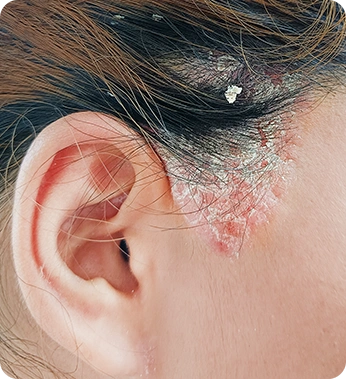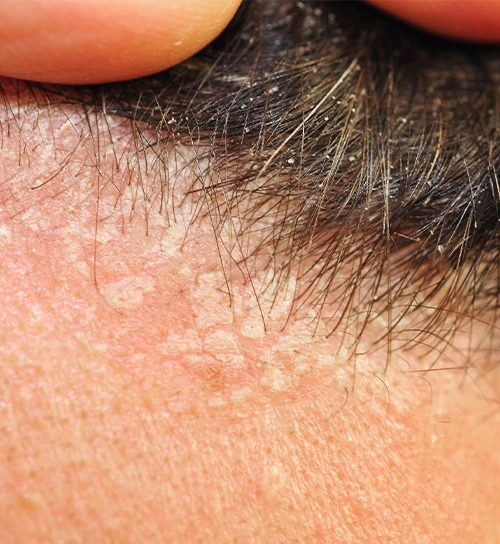Homeopathic Treatment for Seborrheic Dermatitis
Nourish your scalp with expert care
Book your Appointment
Seborrheic dermatitis is a prevalent skin condition characterised by red, inflamed skin and flaky scales, commonly affecting the scalp, face, and other oily areas. Seborrheic Dermatitis affects 1 in every 38 individuals approximately of the Indian population.
Homeopathy offers a natural and effective approach to managing seborrheic dermatitis. At Dr Batra's®, we have achieved a 94% success rate in treating this condition. Our personalised treatment plans aim to address the root causes, providing long-lasting relief and improved skin health
At Dr Batra’s®, we understand the impact of seborrheic dermatitis on your daily life. Our approach includes:
Personalised Assessments
Advanced scalp analysis and consultation to determine the root cause of your condition
Homeopathy
Treating the root cause with natural homeopathic treatment for comprehensive healing.
Holistic Treatment Approach
Emphasis on diet, nutrition, and hair/scalp care to support overall well-being
Expertise & Experience
With over 200 clinics and 300 doctors, we have successfully treated over 1.5 lakh patients globally
Measuring Progress
Regular follow-ups and treatment adjustments to ensure optimal results
Seborrheic dermatitis can be treated naturally and safely with homeopathy. By focusing on the individual's unique symptoms and constitution, homeopathic remedies for seborrheic dermatitis aim to:

Homeopathic treatment offers several advantages:
Natural and Safe
Utilises natural substances with minimal risk of side effects.
Holistic Approach
Affects both the physical and emotional well-being of the individual
Personalised Treatment
Tailored to the individual's specific symptoms and health history
Long-Lasting Relief
Aims for sustained improvement rather than temporary symptom suppression

Seborrheic dermatitis manifests in various forms:
Scalp Dermatitis
Commonly known as dandruff; characterised by a flaky, itchy scalp
Facial Dermatitis
Affects areas like eyebrows, nose, and ears, leading to redness and scaling
Body Dermatitis
This condition occurs in areas such as the chest, back, and armpits and presents as red, inflamed patches.
Seek treatment if you experience persistent symptoms or discomfort or over-the-counter remedies fail to relieve you.
Several factors contribute to the development of seborrheic dermatitis:
Excess Oil Production
Overactive sebaceous glands lead to greasy flakes
Fungal Growth
Overgrowth of Malassezia yeast triggers inflammation
Genetics
A family history of skin conditions increases risk.
Weather Changes
Cold, dry air, or humidity worsens symptoms.
Stress & Lifestyle Factors
Poor diet, stress, and hormonal imbalances contribute
Common symptoms include:
Flaky, white, or yellowish dandruff
Extensive hair fall
Red, irritated scalp or skin patches
Itchy, greasy, and inflamed scalp
Temporary hair thinning due to scalp inflammation
| Approach | Homeopathy | Conventional |
|---|---|---|
| Treats Root Causes | ||
| Homeopathic remedies are tailored to the patient's needs | ||
| 100% Natural & No Side Effects | ||
| Holistic & Long-Lasting Results | ||
| Works for All Skin Types | ||
| Safe for All Ages |
Homeopathic treatment for seborrhoeic dermatitis focuses on addressing the root cause rather than just symptoms. By strengthening the immune system and balancing the body naturally, homeopathic medicine for seborrheic dermatitis on the scalp can help manage the condition effectively, reducing flare-ups and providing long-term relief.
Yes, homeopathic treatment for seborrhoeic dermatitis on the scalp is effective even in severe cases. Homeopathic medicine helps control inflammation, itching, and flaking by treating the underlying imbalance, offering a gentle, side-effect-free solution for long-term scalp health.
Seborrhoeic dermatitis can affect not just the scalp but also the face, ears, chest, and other oily areas of the skin. Homeopathic for seborrheic dermatitis works by regulating oil production and reducing fungal overgrowth, preventing the condition from spreading.
Homeopathic medicine for alopecia areata is safe, natural, and free from side effects. Unlike conventional treatments, it does not contain steroids or harsh chemicals, making it a holistic approach to reducing hair loss and improving scalp health.
The main causes of seborrhoeic dermatitis include excess oil production, Malassezia yeast overgrowth, stress, hormonal changes, and a weakened immune system. Homeopathic medicine for seborrheic dermatitis works by addressing these triggers, offering a natural and long-lasting solution.
The duration of homeopathic treatment for seborrhoeic dermatitis varies depending on severity, lifestyle, and individual response to homeopathic medicine. Many patients see improvement within a few weeks, while long-term results may take a few months.
Doctors treat seborrhoeic dermatitis using homeopathic medicines that help control oil production, reduce inflammation, and prevent flare-ups. Best homeopathic medicine for seborrheic dermatitis is chosen based on individual symptoms to provide a customised and effective treatment plan.
Mild, sulfate-free shampoos, herbal scalp cleansers, and homeopathic-based scalp lotions are ideal for managing seborrhoeic dermatitis. Avoiding harsh chemicals and using homeopathic treatment for seborrhoeic dermatitis on the scalp can help maintain scalp health.
Seborrhoeic dermatitis is a chronic condition but can be effectively managed with homeopathic treatment. Regular use of homeopathic medicine for seborrheic dermatitis on the scalp helps control symptoms and prevent recurrence over time.
Homeopathy offers natural antifungal remedies that help control Malassezia yeast without side effects. The best homeopathic medicine for seborrheic dermatitis is selected based on individual symptoms to reduce itching, flaking, and inflammation.
To prevent seborrhoeic dermatitis from spreading, it is important to maintain scalp hygiene, reduce stress, and follow a proper treatment plan. Homeopathic treatment for seborrheic dermatitis on the scalp strengthens the body’s defense system, reducing the risk of flare-ups and further spread.